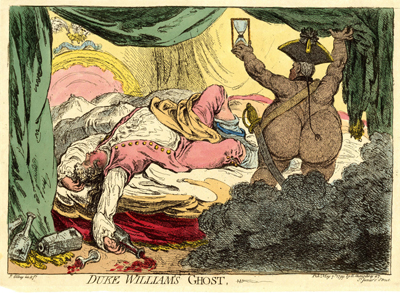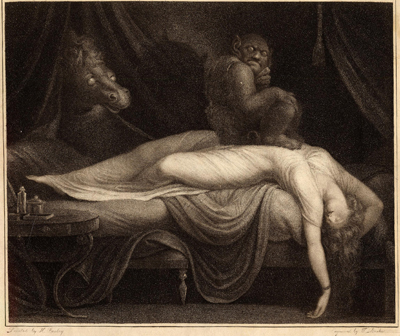Duke William's Ghost
This is one of the prints relegated to the second volume of the Bohn edition with other "suppressed plates" whose subject matter offended Victorian sensibilities. It probably earned that distinction on two counts. First for the portrayal of George III's uncle, William Augustus, Duke of Cumberland—nude (except for his hat and sword). And second for the equally offensive portrait of George's truant son, the Prince of Wales (and future King George IV) nearly falling out of bed in a drunken stupor. Holding up an hour glass in which the sands are running out, the Duke appears to be warning the Prince of the dangers of drink and obesity that led him to an early death at age 44.

© Trustees of the British Museum
The print is likely to have been inspired by some health problems the Prince experienced during a visit to Bath the previous week and a note in the London Times that reported on that episode. Although putting a positive face on the matter the Times of May 9, 1799, admitted "the Prince of WALES is very far from being as well as could be wished."
He was blooded after he arrived in town on Monday evening, as he had been three times at Bath. It is supposed the waters of that place had disagreed materially with him, and occasioned much fever and inflammation.
His Royal Highness is besides occasionally afflicted with spasms in his chest, which do not however create any serious alarm. He is 'au regime,' not being allowed to exceed a fourth glass of wine; but he is in Spirits enough to laugh heartily at the castle stories which have conjured up very different ones in their stead. (p.3)
The raw material for the print is all there. Spasms in his chest, inflammation and fever enough to prompt three rounds of therapeutic bleeding while he was still at Bath and another upon his return to Carlton House. The somewhat laughable regimen of being restricted to four glasses of wine which clearly indicates the extent of the Prince's problem. And a play upon the three meanings of Spirits: the mood or emotion of an individual (e.g. high sprits), strong alcoholic drinks (e.g. port, brandy etc.), and ghosts (such as Duke William). Did the "castle stories" at Windsor include tales of his great uncle's over indulgence? Gillray probably thought so.
The disposition of the Prince of Wales with his head thrown back and arm trailing on the floor owes a general debt to Fuseli's "The Night Mare." which Gillray could have seen when it was displayed at the Royal Academy exhibition in 1782 or in the popular stipple engraving by Thomas Burke in 1783. The visual allusion is appropriate. This is, after all, a nightmare.

The Night Mare
[January 30, 1783]
© Trustees of the British Museum
The fact that Gillray was allowed to publish Duke William's Ghost even though he was now receiving a government pension may have been because the Prince's profligacy was a nightmare for the Royal Family too. The Prince was sensitive about caricatures depicting him. The members of the Family may have thought the print would have a chastening effect.
Sources and Reading
- Commentary from the British Museum on Duke William's Ghost.
- Draper Hill, Mr. Gillray The Caricaturist, 1965, pp.118-19.
- "Prince William, Duke of Cumberland," Wikipedia
- "George IV," Wikipedia
- "Henry Fuseli, The Nightmare," smarthistory
- Thomas Wright and Joseph Grego, The Works of James Gillray, the Caricaturist; With the History of His Life and Times, p. 263.
Comments & Corrections
NOTE: Comments and/or corrections are always appreciated. To make that easier, I have included a form below that you can use. I promise never to share any of the info provided without your express permission.